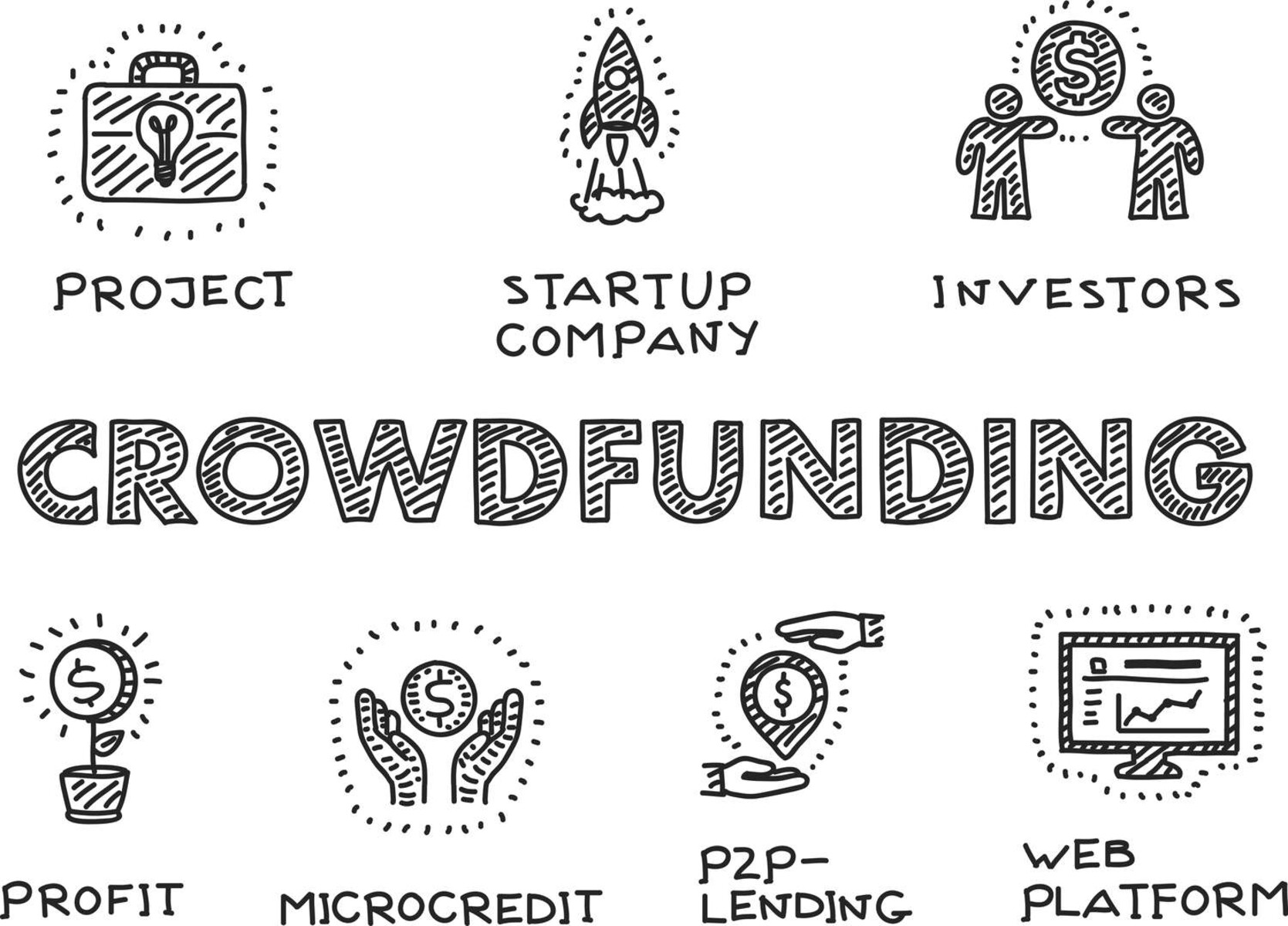Introduction
Welcome to the world of crowdfunding for real estate, where individuals come together to pool their resources and invest in lucrative real estate projects. In recent years, crowdfunding has emerged as a revolutionary way to finance real estate ventures, providing opportunities for both investors and developers.
Traditionally, real estate investments were limited to high-net-worth individuals and institutional investors. However, crowdfunding has opened the doors to a wider range of investors, allowing individuals to participate in real estate deals with lower investment amounts. This democratization of real estate investing has transformed the industry, making it more accessible and inclusive for all.
Why should you consider crowdfunding for your real estate project? The benefits are numerous. Firstly, crowdfunding allows you to access a larger pool of potential investors, increasing your chances of securing the necessary funding. Secondly, it provides an alternative to traditional financing methods, enabling you to bypass the lengthy and often restrictive loan approval processes.
Furthermore, crowdfunding platforms offer a range of tools and resources that can streamline your fundraising efforts. These platforms provide a centralized hub where you can reach out to potential investors, showcase your project, and demonstrate its potential for returns. This online presence not only saves time but also allows you to leverage the power of technology to connect with a global network of investors.
In this article, we will guide you through the process of crowdfunding for real estate. From research and preparation to campaign development and execution, we will provide you with the necessary steps to successfully acquire crowdfunding for your real estate project. So, let’s dive in and explore how you can harness the power of crowdfunding to turn your real estate dreams into a reality!
Why Consider Crowdfunding for Real Estate?
When it comes to financing real estate projects, traditional methods may have their limitations. Banks and financial institutions often have strict lending criteria, making it difficult for individual investors and smaller developers to secure the necessary funds. This is where crowdfunding can offer a viable alternative, revolutionizing the way real estate projects are funded. Here are a few reasons why you should consider crowdfunding for your real estate venture:
- Access to a larger pool of investors: Crowdfunding platforms connect you with a diverse network of potential investors from around the world. This broadens your reach beyond local or traditional sources, increasing the likelihood of finding investors who are interested in your project.
- Diversification of funding sources: By leveraging crowdfunding, you can tap into multiple small investments from a large number of individuals. This diversified funding strategy minimizes the risks associated with relying on a single investor or institution.
- Lower investment thresholds: Crowdfunding allows individuals to invest in real estate projects with lower minimum investment amounts compared to traditional investing. This opens the doors to a wider audience and democratizes real estate investing.
- Faster and streamlined funding process: Traditional financing methods can involve lengthy approval processes and extensive paperwork. Crowdfunding streamlines this process, reducing the time and effort required to secure funding.
- Engagement with investors: Crowdfunding platforms provide a platform for direct engagement with investors. This allows you to build relationships, share updates, and address any concerns or inquiries potential investors may have about your project.
- Showcasing your project’s potential: Through crowdfunding, you can showcase the unique aspects and potential profitability of your real estate project. By highlighting the benefits and returns, you can attract investors who resonate with your vision and investment proposition.
- Market validation: Successfully crowdfunding your real estate project can serve as a validation of its market viability. This can be beneficial when approaching other lenders or investors for additional financing in the future.
Considering these benefits, crowdfunding emerges as an attractive option for funding your real estate ventures. It provides an avenue to access a larger pool of investors, diversify your funding sources, and streamline the financing process. Next, we will explore the step-by-step process of successfully acquiring crowdfunding for your real estate project.
Step 1: Research and Identify Potential Crowdfunding Platforms
Before diving into the world of real estate crowdfunding, it’s important to research and identify the right crowdfunding platforms for your project. Not all platforms are created equal, and each has its own unique features, target audience, and investment criteria. Here are the steps to help you find the most suitable crowdfunding platform:
- Understand your project’s requirements: Begin by assessing your project’s needs and goals. Understand the type of real estate project you are looking to fund, whether it’s residential, commercial, or industrial. Determine the investment amount required, the expected returns, and any specific criteria that may be relevant to your project.
- Research available crowdfunding platforms: Conduct thorough research to identify the crowdfunding platforms that specialize in real estate investments. Look for platforms with a track record of successful projects in your targeted real estate sector. Consider factors such as platform reputation, investor base, and supported geographies.
- Evaluate platform features: Carefully evaluate each platform’s features and offerings. Look for user-friendly interfaces, robust investment tracking tools, secure payment processing, and transparent reporting mechanisms. Consider whether the platform offers additional support services such as legal and marketing assistance.
- Review investment criteria: Pay close attention to each platform’s investment criteria. Some platforms may have minimum investment amounts, geographical restrictions, or specific project requirements. Ensure that your project aligns with their criteria, and consider how well-suited the platform is for your target investor audience.
- Analyze fee structures: Take a close look at the fee structures of the crowdfunding platforms. Understand any upfront fees, ongoing management fees, or success-based fees that may be associated with listing and running a campaign on the platform. It’s important to factor in these costs when assessing the viability of the platform.
- Read reviews and testimonials: Look for reviews and testimonials from developers and investors who have used the platforms. This will give you valuable insights into the platform’s ease of use, responsiveness, and overall experience for both investors and project creators.
- Reach out to the platform: Once you have narrowed down your choices, consider reaching out to the selected platforms for further information. Pose any specific questions or concerns you may have about their services, investment process, or support options. Their response and willingness to assist can give you a good indication of their dedication to customer satisfaction.
By thoroughly researching and identifying potential crowdfunding platforms, you can find the right match for your real estate project. Each platform has its own unique features, investment criteria, and target audience, so choose wisely. Once you have selected the most fitting platform, you can move on to crafting a compelling investment proposal, which we will explore in the next step.
Step 2: Craft a Compelling Investment Proposal
Once you have identified the crowdfunding platform that aligns with your real estate project, it’s time to craft a compelling investment proposal. Your investment proposal serves as a persuasive document that highlights the unique aspects of your project and attracts potential investors. Here are some key steps to help you create an impactful investment proposal:
- Clearly define your project: Start by providing a clear and concise overview of your real estate project. Describe the type of property, its location, and any unique features or benefits that make it an attractive investment opportunity. Explain the purpose of the project, whether it’s for development, renovation, or income generation.
- Highlight the market potential: Conduct thorough market research to identify the demand and potential for your project. Include data and statistics that support your claims, such as population growth, economic indicators, and market trends. This will help investors understand the viability and potential returns of your investment.
- Present a detailed financial analysis: Include a comprehensive financial analysis that outlines the projected costs, revenues, and returns of your real estate project. This should include a breakdown of expenses such as construction or renovation costs, operating expenses, and projected rental incomes or property sales. Consider using graphs or charts to visually represent the financial information.
- Showcase your team’s expertise: Highlight the experience and expertise of your team members who will be involved in the project. This includes developers, architects, contractors, and any other key personnel. Emphasize their past successes and relevant qualifications to instill confidence in potential investors.
- Address risks and mitigation strategies: Acknowledge and address potential risks associated with your real estate project. These may include market fluctuations, regulatory changes, or construction delays. Outline strategies and contingency plans you have in place to mitigate these risks, demonstrating your proactive approach to risk management.
- Include supporting materials: Enhance your investment proposal with supporting materials such as architectural renderings, site plans, and any other visual representations that can help investors visualize the potential of your project.
- Keep it concise and visually appealing: Keep your investment proposal clear, concise, and visually appealing. Use headings, bullet points, and subheadings to break down information and make it easy to digest. Avoid jargon and technical language, and ensure that the document flows logically and is free from errors or inconsistencies.
By crafting a compelling investment proposal, you can effectively communicate the value and potential of your real estate project to potential investors. Take the time to showcase the market potential, financial analysis, and expertise of your team. With a well-crafted investment proposal in hand, you can now move forward to the next step: creating an engaging crowdfunding campaign.
Step 3: Create an Engaging Crowdfunding Campaign
Now that you have a compelling investment proposal in place, it’s time to translate it into an engaging crowdfunding campaign. Your crowdfunding campaign serves as a platform to showcase your project to potential investors and encourage them to contribute. Here are some key steps to create an engaging crowdfunding campaign:
- Create a captivating campaign story: Craft a compelling narrative that captures the essence of your real estate project. Tell the story behind the project, highlighting its unique aspects, purpose, and potential benefits. Connect with potential investors on an emotional level, making them feel excited and invested in your project’s success.
- Use high-quality visuals and videos: Incorporate high-quality visuals such as images, videos, and virtual tours to make your project come alive. Showcasing the property, its surroundings, and any other attractive features can help investors visualize the potential of their investment.
- Break down your funding goal: Clearly define your funding goal and explain how the funds will be utilized. Break down the costs and explain how each investment will contribute to the project’s success.
- Offer attractive rewards: Consider offering rewards or incentives to investors based on the level of their contribution. This can range from exclusive access to project updates, VIP event invitations, or even a share of the project’s profits. Make the rewards enticing and aligned with the investment amount.
- Communicate your project’s social impact: Showcase any positive social or environmental impact your project may have. Highlight community benefits, sustainable features, or job creation opportunities. Investors often value projects that not only offer financial returns but also contribute positively to society.
- Set a realistic timeline: Define a realistic timeline for your project and communicate it clearly to potential investors. This fosters transparency and helps investors understand the expected timelines for returns on their investments.
- Provide regular and timely updates: Throughout your crowdfunding campaign, provide regular updates to keep investors engaged and informed. Share progress, milestones, and any significant developments. This shows your dedication to transparency and builds trust with your supporters.
- Leverage storytelling and testimonials: Incorporate testimonials from satisfied investors, previous clients, or industry experts to build credibility and trust. Share success stories and testimonials that demonstrate your team’s ability to deliver on promises.
- Promote your campaign: Utilize various marketing channels to promote your crowdfunding campaign. Leverage social media, email marketing, PR efforts, and other online platforms to reach a wider audience. Engage with potential investors through Q&A sessions, webinars, or live events to address their questions and build relationships.
- Engage with your existing network: Tap into your existing network of contacts and supporters. Reach out to friends, family, colleagues, and industry connections to spread the word about your crowdfunding campaign. Their support and influence can help generate momentum and attract new investors.
By creating an engaging crowdfunding campaign, you can capture the attention and interest of potential investors. Craft a captivating campaign story, utilize high-quality visuals, and provide clear information on your funding goal and project timeline. Regularly communicate updates and engage with your network and potential investors to build trust and momentum throughout the campaign.
Step 4: Set Realistic Goals and Financial Projections
Setting realistic goals and financial projections is a crucial step in your crowdfunding campaign for real estate. Investors want to see a clear plan and understand the potential returns on their investment. Here are some key steps to help you set realistic goals and financial projections:
- Evaluate project costs: Begin by assessing the costs involved in your real estate project. Consider expenses such as land acquisition, construction or renovation, legal fees, permits, and marketing expenses. Conduct thorough research and consult with professionals to ensure your cost estimates are accurate and comprehensive.
- Forecast potential revenues: Estimate the potential income your project can generate. This may include rental income, property sales, or any other sources of revenue. Take into account market trends, demand for similar properties, and any unique aspects of your project that can contribute to higher returns.
- Consider contingencies: It’s important to factor in contingencies and unexpected costs that may arise during the project. Allocate a portion of your budget as a buffer to account for any unforeseen expenses or delays. This demonstrates your preparedness and risk management strategy to potential investors.
- Conduct a sensitivity analysis: Perform a sensitivity analysis to assess how changes in key variables can impact your financial projections. Consider factors such as interest rates, market conditions, and construction costs. This analysis will help you understand the potential risks and uncertainties associated with your project.
- Set realistic return expectations: Based on your cost estimates and revenue projections, set realistic return expectations for your investors. Take into consideration factors such as the project’s timeline, market conditions, and potential risks. Be transparent about the potential risks and returns to manage investor expectations.
- Include a detailed financial model: Develop a detailed financial model that outlines the projected income, expenses, and cash flows over the duration of the project. This model should incorporate factors such as financing costs, taxes, and anticipated exit strategies. Present the financial model in a clear and visually appealing format to facilitate understanding.
- Seek expert advice: Consider seeking advice from financial professionals or consultants with experience in real estate investment analysis. They can provide valuable insights and help you refine your financial projections based on market trends and industry standards.
- Be conservative in your projections: It’s better to be conservative in your financial projections rather than overly optimistic. Investors appreciate realistic and well-grounded projections that acknowledge potential risks. This builds trust and credibility, increasing the likelihood of attracting investors.
By setting realistic goals and financial projections, you demonstrate your understanding of the project’s costs, potential revenues, and associated risks. Thoroughly evaluate project costs, forecast revenues, and consider contingencies. Develop a comprehensive financial model and seek expert advice to refine your projections. Being transparent and conservative in your projections will help build trust and credibility among potential investors.
Step 5: Develop a Marketing Strategy
A well-designed marketing strategy is essential for the success of your crowdfunding campaign. It involves reaching out to potential investors, creating awareness about your project, and compelling them to contribute. Here are key steps to help you develop an effective marketing strategy:
- Identify your target audience: Determine the specific group of investors you want to target for your real estate project. Understand their demographics, interests, investment preferences, and motivations. This will help you tailor your marketing messages and choose the most effective channels to reach them.
- Create a compelling brand identity: Develop a unique and compelling brand identity for your project. This includes a logo, tagline, and visual elements that resonate with your target audience. A strong brand can help differentiate your project and make it more memorable to potential investors.
- Build a professional project website: Create a dedicated website that showcases your real estate project in a professional and appealing manner. Include vivid project descriptions, high-quality images, videos, and testimonials to engage and captivate potential investors. Ensure that your website is mobile-friendly and optimized for search engines.
- Leverage social media: Utilize social media platforms that resonate with your target audience. Create engaging content that highlights the unique aspects of your project and encourages sharing and interaction. Use relevant hashtags and join real estate or investment communities to expand your reach.
- Develop compelling content: Produce high-quality and informative content that educates and engages your target audience. This can include blog articles, videos, infographics, or case studies relevant to the real estate industry. Demonstrate your expertise and provide valuable insights to build trust and credibility.
- Collaborate with influencers: Identify and reach out to influencers or industry experts who can endorse your project and amplify your message. Their endorsement can add credibility and attract a wider audience of potential investors.
- Engage in email marketing: Build an email list of individuals interested in real estate investments. Regularly communicate updates, milestones, and exclusive information to keep them engaged and informed throughout your crowdfunding campaign.
- Optimize for search engines: Ensure that your project website and other online content are optimized for search engines. Use relevant keywords, meta tags, and descriptions to improve your website’s visibility in search engine results. This can help drive organic traffic and increase your chances of reaching potential investors.
- Create engaging visuals and videos: Visuals and videos can have a significant impact in capturing attention and conveying the unique features of your project. Invest in professional photography and videography to create visually appealing and compelling visuals that highlight the potential of your real estate project.
- Promote offline: Don’t limit your marketing efforts to the online realm. Explore opportunities to promote your project offline, such as hosting informational seminars or participating in real estate conferences and events. These avenues can help establish credibility and attract potential investors who prefer face-to-face interactions.
By developing a comprehensive marketing strategy, you can raise awareness about your real estate project and attract potential investors. Identify your target audience, create a compelling brand identity, and build a professional website. Leverage social media, email marketing, and search engine optimization to expand your reach. Collaborate with influencers and create engaging content to build credibility and engagement. Remember to integrate offline marketing efforts to reach a wide range of potential investors.
Step 6: Engage with Potential Investors and Leverage Your Network
Engaging with potential investors and leveraging your existing network is crucial in gaining support for your crowdfunding campaign. Building personal connections and trust can significantly increase the likelihood of attracting investments. Here are some key steps to effectively engage with potential investors and leverage your network:
- Create a compelling elevator pitch: Craft a concise and persuasive elevator pitch that clearly communicates the value and potential returns of your real estate project. This pitch should be captivating and succinct, capturing the attention of potential investors within a short timeframe.
- Reach out to friends, family, and colleagues: Start by sharing your crowdfunding campaign with your immediate network. Talk to friends, family members, and colleagues about your project and the investment opportunity it presents. Their support and contributions can help create momentum and attract further investments.
- Utilize online networking platforms: Leverage professional networking platforms such as LinkedIn to connect with potential investors. Join real estate investment groups, participate in industry discussions, and establish connections with individuals who have expressed interest in real estate projects.
- Nurture relationships with previous investors: If you have previous investors or individuals who have shown interest in your real estate projects, nurture those relationships. Keep them updated on your current project and the crowdfunding campaign. They may be more likely to invest again or recommend your project to others.
- Engage in personal outreach: Take the time to personally reach out to individuals who have shown interest in your project or expressed a curiosity about real estate investment. Send personalized emails, schedule phone calls, or meet in person to discuss the investment opportunity and address any questions or concerns they may have.
- Host informational webinars or events: Organize webinars or in-person events to provide potential investors with a deeper understanding of your project and the investment potential it offers. Invite industry experts to speak, present case studies, and answer questions to enhance the credibility of your project.
- Offer exclusive access to project updates: Provide potential investors with exclusive access to project updates, progress reports, and behind-the-scenes content. This gives them a sense of being involved in the project and helps build trust and excitement around the investment opportunity.
- Engage with inquiries promptly and professionally: Respond to inquiries or questions from potential investors in a prompt and professional manner. Be prepared to address concerns, provide additional information, or facilitate discussions with your team members. This shows your commitment and dedication to investor experience.
- Utilize referrals and testimonials: Encourage satisfied investors to refer your campaign to their network or provide testimonials. Word-of-mouth recommendations and positive testimonials can carry significant weight and attract potential investors.
- Consider a personalized approach: Tailor your engagement strategy to each potential investor’s interests and preferences. Understand their investment goals, risk appetite, and desired level of involvement. Personalizing your approach shows that you value their individual needs and can increase their confidence in your project.
By actively engaging with potential investors and leveraging your existing network, you can build relationships, establish trust, and attract investments for your crowdfunding campaign. Craft a compelling elevator pitch, reach out to friends and colleagues, and utilize online networking platforms. Actively nurture relationships with previous investors, engage in personal outreach, and host informational webinars or events. Promptly respond to inquiries, offer exclusive access to updates, and leverage referrals and testimonials. A personalized approach can make potential investors feel valued and increase their likelihood of supporting your real estate project.
Step 7: Utilize Social Media and Online Promotion Channels
Social media and online promotion channels are powerful tools that can amplify the reach of your crowdfunding campaign for real estate. These platforms allow you to connect with a vast audience, generate awareness, and attract potential investors. Here are key steps to effectively utilize social media and online promotion channels:
- Choose the right platforms: Identify the social media platforms that are most popular among your target audience. Focus your efforts on platforms such as Facebook, Twitter, Instagram, LinkedIn, or YouTube, depending on where your potential investors are most active.
- Create a consistent brand presence: Establish a consistent brand identity across all your social media and online promotion channels. Use consistent branding elements such as logos, colors, and themes to create a recognizable presence. This builds trust and helps potential investors recognize your project across different platforms.
- Develop engaging content: Create compelling content that captures the attention and interest of your target audience. This can include blog articles, videos, infographics, or behind-the-scenes glimpses of your real estate project. Provide valuable insights and information related to real estate investing to position yourself as an authority in the field.
- Utilize targeted advertising: Leverage the advertising capabilities of social media platforms to reach a wider audience. Utilize targeting options such as demographics, interests, and location to ensure that your ads are shown to individuals who are most likely to be interested in your real estate project.
- Engage with your audience: Actively engage with your social media followers and online audience. Respond to comments, answer questions, and foster conversations related to your project. This helps build relationships and establishes a community around your campaign.
- Collaborate with influencers: Identify influencers or industry experts who have a significant following in the real estate or investment space. Partner with them to promote your crowdfunding campaign. Their endorsement and reach can greatly amplify your message and attract potential investors.
- Encourage user-generated content: Encourage your social media followers and online audience to generate content related to your project. This can include sharing their thoughts, experiences, or photos related to real estate investments. User-generated content adds credibility and authenticity to your campaign.
- Run contests or giveaways: Organize contests or giveaways on social media platforms to incentivize engagement and attract attention. This can involve offering exclusive access to project updates, merchandise, or even a chance to win a small financial stake in the real estate project.
- Partner with real estate associations or communities: Collaborate with real estate associations or communities that have a strong online presence. Contribute valuable content or participate in online discussions to establish yourself as a respected and knowledgeable participant in the industry.
- Monitor and analyze performance: Regularly monitor and analyze the performance of your social media and online promotion efforts. Keep track of metrics such as engagement, reach, and conversion rates. This allows you to fine-tune your strategies and optimize your campaign for better results.
By utilizing the power of social media and online promotion channels, you can significantly increase the visibility and reach of your crowdfunding campaign. Choose the right platforms, develop engaging content, and consider targeted advertising. Actively engage with your audience, collaborate with influencers, and encourage user-generated content. Run contests or giveaways to incentivize engagement and consider partnering with real estate associations or communities. Continuously monitor and analyze your performance to refine your strategies and maximize the impact of your online presence.
Step 8: Monitor and Update Your Crowdfunding Campaign
Monitoring and updating your crowdfunding campaign is essential to ensure its success. By staying actively involved throughout the campaign, you can make informed decisions, address any challenges, and keep your investors engaged. Here are key steps to effectively monitor and update your crowdfunding campaign:
- Track campaign performance: Regularly monitor the performance of your crowdfunding campaign. Keep a close eye on key metrics such as the amount raised, the number of backers, and the conversion rate. This information will give you insights into the effectiveness of your marketing efforts and help you identify areas that require improvement.
- Respond to investor inquiries promptly: Be responsive to inquiries and questions from potential investors or existing backers. Address any concerns or provide clarifications promptly and professionally. This shows your commitment to transparency, builds trust, and encourages investor confidence in your project.
- Update your campaign page: Continuously update your campaign page to provide new information, project updates, and any milestones achieved. Use captivating visuals and engaging content to keep potential investors interested and excited about your project.
- Share progress on social media: Regularly share updates and progress on your social media channels. This keeps your audience informed and engaged, ensuring that your campaign remains top-of-mind. Use visuals, videos, and testimonials to make your updates more engaging and shareable.
- Offer stretch goals or incentives: Consider offering stretch goals or additional incentives as your campaign progresses. This keeps the momentum going and encourages existing backers to increase their contributions. It can also attract new backers who are enticed by additional rewards or benefits.
- Engage with your backers: Actively engage with your backers throughout the campaign. Provide regular updates directly to their inbox and include them in the journey of your project. Offering exclusive access or behind-the-scenes content can make them feel like valued participants in your real estate venture.
- Seek feedback and make improvements: Encourage feedback from your backers and potential investors. Pay attention to their suggestions and ideas, and consider integrating them into your campaign or project. This shows that you value their opinions and are committed to delivering a successful project.
- Attend to any challenges or setbacks: In any crowdfunding campaign, challenges or setbacks may arise. It’s essential to address these issues promptly and transparently. Communicate openly with your backers, share your plans to overcome the obstacles, and demonstrate resilience and determination in achieving your project goals.
- Express gratitude to your backers: Show appreciation to your backers for their support and contributions. Express your gratitude publicly and personally to acknowledge their trust and confidence in your project. This helps foster positive relationships and encourages continued support.
- Adapt your strategy if needed: If you notice that certain marketing or promotional strategies are not delivering the desired results, be open to adapting and adjusting your approach. Monitor the performance of your marketing channels and make data-driven decisions to optimize your campaign for better outcomes.
By actively monitoring and updating your crowdfunding campaign, you can ensure its success and maintain investor engagement. Track campaign performance, respond to inquiries promptly, and update your campaign page with relevant information. Share progress on social media, offer stretch goals or incentives, and engage with your backers. Seek feedback, address challenges transparently, and express gratitude to your supporters. Adapt your strategy if needed to maximize the impact of your crowdfunding campaign.
Step 9: Manage Investor Relations and Communication
Managing investor relations and communication is a crucial step in your crowdfunding campaign for real estate. Building strong relationships with your investors and keeping them informed throughout the project is vital for maintaining their support and confidence. Here are key steps to effectively manage investor relations and communication:
- Establish clear communication channels: Set up clear and efficient communication channels with your investors. This can include email newsletters, regular project updates, and a dedicated investor portal on your website. Ensure that investors have an easy and convenient way to reach out to you with their questions, concerns, or feedback.
- Provide regular project updates: Keep your investors informed about the progress of the real estate project. Provide regular updates on milestones, construction developments, or any significant news related to the project. Transparency and regular communication foster trust and confidence among your investors.
- Hold informative investor meetings or webinars: Organize periodic investor meetings or webinars to provide detailed project updates and address any questions or concerns. This gives investors an opportunity to engage directly with you and gain a deeper understanding of the project’s progress.
- Be responsive and proactive: Respond to investor inquiries and communications promptly and professionally. Address their questions, concerns, or requests for additional information in a timely manner. Proactive communication demonstrates your commitment to investor satisfaction and builds strong relationships.
- Provide financial transparency: Maintain financial transparency by sharing regular financial reports or statements with your investors. This includes updates on the use of funds, income generated, and any expenses incurred. Clear and transparent financial reporting builds trust and promotes investor confidence.
- Regularly assess and manage risks: Continuously assess and manage risks associated with the real estate project. Communicate any potential risks or challenges to your investors and outline your strategies for mitigating and managing these risks. This proactive approach shows your commitment to protecting their investments.
- Seek investor feedback: Actively seek feedback from your investors on their experience with the crowdfunding campaign and their overall satisfaction. This could be done through surveys or individual conversations. Use their feedback to improve your investor relations strategies and make necessary adjustments to meet their expectations.
- Host investor appreciation events: Show gratitude and appreciation to your investors by organizing investor appreciation events or exclusive gatherings. This provides an opportunity for them to meet and network with other investors and key project stakeholders. It reinforces their sense of belonging and demonstrates your commitment to building a community around your project.
- Handle investor conflicts professionally: In the event of conflicts or disputes among investors, handle them professionally and impartially. Actively listen to all parties involved, seek to understand their concerns, and work towards finding a resolution that is fair and equitable for all investors.
- Stay compliant with legal and regulatory requirements: Ensure that you are up to date with any legal and regulatory requirements related to investor communications and reporting. Comply with the necessary regulations to establish trust and maintain a strong reputation with your investors.
By effectively managing investor relations and communication, you can cultivate strong relationships with your investors and maintain their support throughout the real estate project. Establish clear communication channels, provide regular updates, and hold informative meetings or webinars. Be responsive, proactive, and maintain financial transparency. Seek feedback, host investor appreciation events, and handle conflicts professionally. Stay compliant with legal requirements and regulations to instill trust and confidence in your investors.
Step 10: Execute Your Real Estate Project
The final step in your crowdfunding campaign for real estate is to execute your project. This is the stage where you turn your vision into a reality and deliver on your promises to your investors. Here are key steps to successfully execute your real estate project:
- Secure the necessary funding: With the support of your investors, ensure that you have secured the necessary funding to proceed with your real estate project. Adhere to any legal or contractual obligations related to the use of funds and keep investors informed about the progress.
- Engage with your project team: Work closely with your project team, including architects, contractors, and other professionals involved in the development or renovation process. Maintain regular communication, monitor progress, and address any issues or challenges that may arise during the execution phase.
- Adhere to timelines and milestones: Follow the timelines and milestones outlined in your project plan. Keep investors informed about major accomplishments and milestones achieved throughout the execution process. This helps build credibility and trust, as investors can see that their investments are being put to good use.
- Monitor project expenses: Keep a close eye on project expenses to ensure they remain within the allocated budget. Regularly review financial reports and make necessary adjustments to avoid any cost overruns. Transparent financial management instills confidence in your investors and demonstrates your commitment to delivering value.
- Address construction or renovation challenges: During the execution phase, challenges and obstacles may arise. It is important to proactively address these challenges and communicate the solutions to your investors. Keep them updated on any delays or changes that may impact the project timeline.
- Communicate progress to investors: Continuously communicate the progress of your real estate project to your investors. Share updates, photos, and videos showcasing the development or renovation process. Engage with your investors and address any questions or concerns they may have.
- Ensure compliance with legal and regulatory requirements: Adhere to all legal and regulatory requirements related to your real estate project. This includes obtaining necessary permits, conducting inspections, and complying with zoning and safety regulations. Compliance fosters trust and protects the interests of both your investors and project stakeholders.
- Maintain quality control: Ensure that your project maintains high-quality standards at every stage of execution. Regularly monitor the work being done, conduct quality inspections, and address any issues promptly. Meeting or exceeding quality expectations assures investors that their investment is being used responsibly and that the project will deliver on its promised outcomes.
- Deliver on promised returns: Once the project is complete, deliver on the promised returns to your investors. Provide them with the expected rental income, profits from property sales, or any other agreed-upon benefits. Transparently communicate the financial outcomes and showcase the successful realization of the project.
- Maintain post-project communication: Even after the project is complete, maintain open lines of communication with your investors. Provide post-project updates, ensure a smooth transition to ongoing operations, and proactively address any post-implementation questions or concerns. Sustaining relationships with investors can lead to future investment opportunities and continued support.
By successfully executing your real estate project, you fulfill the promises made to your investors during the crowdfunding campaign. Secure the necessary funding, engage with your project team, and adhere to timelines and milestones. Monitor project expenses, address challenges, and communicate progress to investors. Ensure compliance with legal requirements, maintain quality control, and deliver on promised returns. Continue post-project communication to foster ongoing relationships with your investors and capitalize on future opportunities.
Conclusion
Crowdfunding has revolutionized the way real estate projects are funded. It provides an opportunity for developers and investors alike to come together and make real estate dreams a reality. By following the ten steps outlined in this guide, you can navigate the crowdfunding process successfully and maximize your chances of securing the necessary funds for your real estate project.
From researching and identifying potential crowdfunding platforms to executing your real estate project, each step plays a crucial role in the overall success of your crowdfunding campaign. By conducting thorough research, crafting a compelling investment proposal, and engaging with potential investors, you can generate excitement and attract the support needed to achieve your funding goals.
Effective marketing strategies, such as utilizing social media and online promotion channels, allow you to reach a wider audience and raise awareness about your project. Building strong relationships and maintaining open communication with investors throughout the campaign and project execution phase is essential to fostering trust and garnering long-term support.
Executing your real estate project involves adhering to timelines, managing finances, and ensuring compliance with legal and regulatory requirements. By delivering on your promises and providing transparent updates, you can instill confidence in your investors and demonstrate your commitment to their financial success.
Remember, the crowdfunding journey for real estate is not just about securing funds, but also about building relationships, fostering trust, and delivering value. By following the steps outlined in this guide, you are well-equipped to embark on a successful crowdfunding campaign for your real estate project. Turn your vision into reality and leverage the power of crowdfunding to make your real estate dreams come true.











![How Does Crowdfunding Work? [Beginner-Friendly]](https://robots.net/wp-content/uploads/2020/07/How-does-crowdfunding-work-300x212.jpg)













